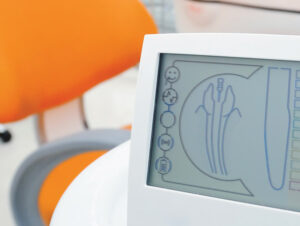The Bottom Line on Electronic Apex Locators
Successful root canal treatment depends on establishing an accurate working length, and, toward this goal, electronic apex locators (EAL) are considered a key modality for obtaining this critical measurement.

Successful root canal treatment depends on establishing an accurate working length, and, toward this goal, electronic apex locators (EAL) are considered a key modality for obtaining this critical measurement. Additionally, these units can help determine the location of perforations that occur through internal/external resorption or treatment mismanagement. Yet, despite this utility, it is important to understand the role of these devices in endodontic therapy, and not rely exclusively on a single technology.
Describing EALs as “another accessory in the endodontic armamentarium,” Eugene A. Pantera Jr., DDS, MS, provides perspective, noting, “Treating with an EAL does not negate the use of other working-length determinants, such as radiographs, cone beam imaging, bleeding point, tactile sensation, and patient sensitivity. All should be used to verify where the clinician wishes to establish working length.”
Characterizing an accurate working length as the standard of care in endodontics, Pantera, a clinical associate professor emeritus at the University at Buffalo, where he directed the Division of Endodontics, explains that “working length is generally considered as the distance between a subjective coronal reference point and the physiologic apical foramen — that is, the apical constriction. In uncomplicated endodontic cases, the EAL is the quickest and most accurate method of obtaining working length, with an approximate 90% accuracy that varies with technique and situation. Their main advantage is reducing radiation exposure to the patient by not needing multiple radiographic images. Another plus is that EALs save chairtime.”
Despite marketing claims, Pantera cautions that EALs are not 100% accurate all of the time. As such, he asserts a radiograph “should always be taken to confirm working length, whether it is with a file or to verify the fit of a master cone.” Noting the apical constriction is thought to have a resistance of 6500 Ω — a value around which most EALs are calibrated — he says each unit uses different electronics and algorithms to measure the resistance and capacitance of the circuit between the lip clip and file tip. Accordingly, Pantera emphasizes the need to follow the instructions for each EAL device, and not “wing it” based on prior usage of another unit.
“Providers also need to apply their individual treatment philosophy; meaning, where do they want the working length in relation to the EAL’s endpoint signal — at the endpoint signal or some distance short of that? This is key,” he says, “because endodontic success comes from cleaning, shaping and obturating within a determined working length.” Among other variables affecting treatment outcomes, common sense plays an important role. “For example, teeth generally have a working length of 21 (± 2) mm. If the EAL yields a measurement of, say, 15 mm, the operator should pause and reassess. Has a technique error occurred? Or is there a problem with the tooth?”
Commenting on the six generations of EAL technology, Pantera observes that fourth-generation units are still the most popular, but cannot be used in fluid-filled canals. However, he points out that most techniques suggest some cleaning of the canal before electronic measurement. In comparison, fifth-generation EALs can work in any type of canal, whether dry or wet with fluids. Similarly, six-generation units — known as adaptive apex locators — can assess canal humidity and adapt to wet or dry conditions. However, he reports neither is as widely used as fourth-generation technology.
When asked about the repeatable predictability of today’s EALs, Pantera says clinical skill, experience and judgment loom large when establishing working length. Citing a colleague’s paraphrasing of Yogi Berra, he notes, “Endodontics is 90% mental; the other half is skill. Using the latest technology is unproductive if the user can’t negotiate, clean, and obturate canals with competence.”
From Decisions in Dentistry. January 2022;8(1):46.


